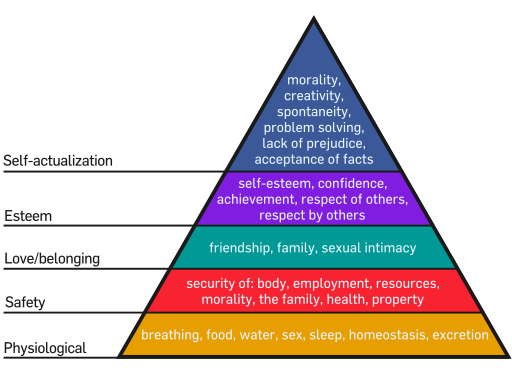We know for a fact that biological and psychological needs drive our existence. More specifically, by our desire to fulfill our needs and live a joyous life.
We need food and water to survive; a roof over our head to satisfy our need for comfort, and exciting activities to fill our need for self-fulfillment and happiness.
But which are the fundamental needs that drive our existence? Is there a way to categorize them? Do all humans have the same needs? What motivates us to pursue our needs?
And most importantly, does happiness boil down to satisfying our needs?
Perhaps Maslow’s Hierarchy of Needs might be the answer to our search for lasting happiness. But first, let’s take a closer look at the life and work of Abraham Maslow.
Who Was Abraham Maslow?
Abraham Maslow was among the most influential figures in modern psychology. His works on human motivation and his keen interest in humanistic psychology have brought significant contributions to a field of study which, at that time, was struggling to win its place among reputable sciences.
As a psychologist, Maslow was passionate about Freudian psychoanalysis and behavioral psychology, two opposing ‘forces’ which sought to explain the human psyche.

Being unsatisfied with psychoanalysts’ focus on the pathological aspects of the human mind and the behaviorists’ apparent lack of interest in the crucial differences between humans and animals, Maslow turned to humanistic psychology.
And that’s when he began to explore motivation and the human potential for growth and achievement. In a way, we could argue that Maslow was one of the first psychologists to place a strong emphasis on the positive aspects of human existence. [1]
In other words, instead of seeking to ‘fix’ the negative or pathological aspects of the human mind, he chose to explore ways in which individuals could overcome their shortcomings and achieve lasting happiness.
The ‘crown jewel’ of his life’s work is the Pyramid of Needs, a framework for personal and professional growth used by numerous psychologists and coaches to help their clients achieve a healthy, happy, and satisfying life.
What is Maslow’s Hierarchy of Needs?
One of the most popular theories of modern psychology is Maslow’s Hierarchy of Needs.
This entire model which seeks to explain human motivation and personal growth is based on a straightforward idea – human beings possess a set of needs that drive their everyday existence. In other words, the motivation to pursue specific goals is fueled by our desire to satisfy our needs.
After extensive research, Maslow realized that human needs could be classified based on the importance that we attribute to each one of them. And that’s how the 5-step hierarchy of needs became a reference point for authentic growth.
As you can see, there are five levels, each with its own set of needs:
- Physiological – the basic necessities that ensure our survival and are specific to almost every being on this planet.
- Safety – refers to needs that ensure our survival but are mostly specific to human beings.
- Love/Belonging – reflects our need for meaningful social interactions that ensure our survival and growth as social creatures
- Esteem – represents complex psychological needs that drive us to seek more than just an average life.
- Self-actualization – is the top of the pyramid and it’s made up of aspects related to personal growth.
The first two levels (physiological and safety) are called basic needs while the next two (love/belonging and esteem) can be classified as psychological needs. The top level (self-actualization) represents our self-fulfillment needs.
But there is another way to look at the Hierarchy of Needs, and that is by classifying the first four levels (psychological, safety, love/belonging, and esteem) as deficiency needs, while the top level represents our growth needs.
From this perspective, the first four levels of needs motivate us to act when they’re unmet. The more we delay satisfying these needs, the stronger they get. For example, the more we go without water, the thirstier we get.
As for growth needs, they tend to influence motivation differently. In other words, the more we engage in activities that satisfy our needs for growth and self-actualization, the stronger our motivation to pursue these needs.
Maslow believed that people need to fulfill their lower level needs before they can focus on the upper levels of the pyramid. For example, once you’ve satisfied your safety needs to a reasonable extent, you can start focusing on love/belonging needs.
Or, to put it in a different form, you can’t meet someone and start a family if you don’t have a job and a roof over your head.
The Hierarchy of Needs doesn’t imply that those of us who are focusing on ‘higher’ needs such as self-actualization are somehow better than the rest (who might be still stuck on the third or fourth level).
Each and every one of us can climb to the top of the pyramid.
It’s not a competition where we try to ‘outrun’ others, in our journey toward fulfillment and happiness.
The Hierarchy of Needs refers to inner growth and provides a framework that allows us to organize our day-to-day life in a way that ensures healthy and stable growth on all levels.
There’s really no point in rushing it since higher needs do not arise if lower needs are not met.
How Did Maslow See Human Motivation and Growth?
According to Abraham Maslow, our day-to-day actions and decisions are driven by a desire to satisfy various physiological and psychological needs.
For example, we wake up in the morning and go to work because we need to earn money for groceries, bills, clothes, and other necessities, thus satisfying our biological and safety needs.
Or, we hang out with friends and invest time in meaningful relationships to satisfy our need for love and belonging.
And once we manage to satisfy our basic needs, we can move up the hierarchy and focus on complex needs such as esteem and self-actualization.
Unfortunately, very few people manage to reach the top of the pyramid. In other words, only a fraction of the population can afford the luxury of living a life governed by morality, spontaneity, lack of prejudice, and creativity. And it’s not because we don’t have what it takes to get to the top, but because we often fail to stick to a clear plan.
Many of us seem to linger on the lower levels, struggling to achieve financial stability, get a mortgage, and find our significant other. There are also those who think material wealth is enough to guarantee a happy life. However, once they manage to fulfill this need, they quickly realize they’re not as happy as they thought they would be.
Authentic happiness and fulfillment come when you reach the top of the pyramid where you will find the perfect balance between your ideal self and your real self.
People who are at that level tend to live unconventional lives. They are confident in their abilities, free of judgments, self-aware, and sensitive to the world they live in.
For Abraham Maslow, human motivation and personal growth were the expression of our physiological and psychological needs. The higher you climb on your hierarchy of needs the closer you are to what you believe authentic happiness is.
Is Maslow’s Hierarchy Useful in Our Quest for Happiness?
In Maslow’s views, the secret to authentic happiness is reaching the top of the pyramid. However, that’s easier said than done. The road from physiological needs to self-actualization needs is long and demanding, but it’s worth all the time and effort in the world.
You only have one life; you’re only going to be here for a limited time. Do you want to spend your days living an ‘average’ life or seize the moment and reach for authentic happiness?
When you cease to drift through life absent-minded and choose to be in control of your destiny, good things will happen.
People who’ve reached the top of the pyramid have a clearly defined personality. They are charismatic, and they seek to inspire those around them. And that’s because climbing their hierarchy of needs has taught them to accept themselves – with qualities and flaws – and prioritize their needs above everything else.
They are not afraid to show the whole world their true colors and interact authentically.
Recent studies indicate that for people who are under hospice care, Maslow’s hierarchy of needs can be a viable tool for achieving human potential. [2] For terminally ill patients and people who are dealing with chronic conditions, knowing they can still significantly boost their overall sense of well-being.
Furthermore, some experts believe this needs-based model can even explain police organizational behavior. As one 2017 study has concluded,
“Lower hierarchy of needs tends to be associated with pursuit of traditional policing while a community with higher level needs tend to pursue community policing. Similarly, organizational complexities influence the implementation of different policing models.” [3]
In other words, communities where individuals can easily satisfy their physiological and safety needs, tend to drift away from traditional policing and move towards community policing where officers are in a proactive partnership with citizens.
All and all, it seems Maslow’s Hierarchy of Needs proves to be a valuable approach, with serious implications on an individual and social level.
But climbing the pyramid s a lifelong journey filled with challenges that can quickly throw you off path. You need patience and determination is you wish to achieve lasting happiness.
Fortunately, a step-by-step approach can help you reach the self-actualization level and reap the benefits of a truly joyous and fulfilling life.
The Five Levels of Maslow’s Hierarchy of Needs (And How to ‘Climb’ It):
1. Physiological
The first level of the pyramid is made up of physiological needs like the need for water, food, sleep, sex, breathing, and excretion.
These are the needs that forced us to abandon our predator (often solitary) instincts and work together towards the common good. Without satisfying our basic needs, we would quickly cease to exist.

As you can probably imagine, physiological or basic needs are self-explanatory. It’s hard to focus on the upper levels of the pyramid when you’re having trouble satisfying your basic needs.
In other words, when you’re struggling to put food on the table, you won’t be preoccupied with subjects like spirituality, ethics, or the quest for happiness.
Although our society has evolved to a point where biological needs no longer pose a challenge, problems like food insecurity or lack of drinking water continue to affect parts of the world.
Once you’ve managed to satisfy your physiological needs, you can start thinking about more complex needs like security or love.
Tips to help you master this level:
- Invest in healthy eating habits
- Drink plenty of water
- Get a good night’s sleep
- Avoid working yourself ‘til exhaustion
2. Safety/Security
When you’ve successfully satisfied your biological needs, you can move up the pyramid and preoccupy yourself with physical and psychological safety. Any danger that threatens your physical and mental integrity must be avoided at all costs.

Since we’re living in a world where we rarely need to worry ourselves with physical safety – no saber-tooth tigers are chasing us through the jungles anymore – our safety needs often refer to financial security like a guaranteed minimum income, a savings account, or a decent pension plan).
For example, a stable job cultivates a sense of security that allows us to enjoy the psychological comfort we need to live a worry-free life.
In the absence of physical safety, which can easily be affected by wars, natural disasters, civil unrest, domestic violence, childhood abuse, and other similar events, people can develop all sorts of problems like trauma or post-traumatic stress.
Tips to help you master this level:
- Invest several streams of income
- Get a decent healthcare insurance
- Create a savings account
- Get rid of any habit that may affect your overall health and well-being
- Develop habits that help you prevent physical and psychological problems
3. Love/Belonging
We know for a fact that human beings are social creatures. In fact, one of the main reasons why we managed to survive and thrive is our ability to work together and achieve collective growth.
When your biological needs are met, and you feel safe (physically and mentally), you can start focusing on your ‘social’ needs. In other words, you climb up to the third level of the hierarchy where you will seek to satisfy your need for love and belonging.

Nowadays, just like in the past, it’s almost impossible to live alone, isolated from society. You need to be part of a group that can provide emotional and even financial support when the going gets tough. You need people who love and respect you enough to care about your well-being.
On a professional level, social interactions give rise to exciting opportunities. In other words, you need to work side by side with others, delegate tasks to people you trust, and pitch potential business ideas to investors.
Some examples of deficiencies at this level would be abuse, neglect, or social isolation which can have destructive consequences on your emotional well-being.
As a result, you might find it impossible to cultivate and maintain meaningful relationships based on emotional connectedness, intimacy, and respect.
All and all, reaching the third level of the pyramid marks the beginning of personal growth. This is the stage where you’re no longer focusing solely on survival, but on personal and professional development as well.
Tips to help you master this level:
- Spend quality time with your loved ones
- Go to networking events
- Participate in team sports
- Do something nice for a colleague/coworker
- Take the time to meet your neighbors
- Get a pet
- Get involved in volunteer work
- Take your significant other on a lovely date
4. Esteem
The fourth level of the pyramid symbolizes our needs for acceptance and respect.
Each and every one of us wants to feel accepted, appreciated, and respected by our friends, family members, and peers. This represents the foundation of self-esteem, a psychological aspect that drives motivation and pushes us to engage in activities that boost happiness and well-being.

In general, we seek to choose professions where others will recognize our talents and abilities, thus creating an environment where we feel respected and accepted.
Another way to receive praise and respect from people around us is by investing in hobbies. Doing something you enjoy leads to spectacular results which, in turn, attracts other people’s attention and appreciation.
But your need for esteem and respect shouldn’t be entirely dependent upon other people’s reactions. You can boost your self-esteem and self-respect by simply adopting an attitude that is in line with your core values. Or, as Maslow explained, finding the balance between your real and ideal self.
People with low self-esteem will always seek validation from the outside, even though this approach strips them of control and prevents them from accessing their inner strength. This can further lead to feelings of helplessness, self-doubt, a complex of inferiority that fuels anxiety and depression.
Overall, satisfying your need for acceptance and respect should result from a mix of inner and outer factors.
Once you begin to practice self-acceptance and self-respect other people’s negative remarks will cease to bother you. In fact, you might be surprised to discover that others appreciate you simply because you project self-confidence.
Tips to help you master this level:
- Discover your strengths and weaknesses
- Spend quality time with people who love and appreciate you
- Pick up a new hobby, something that gets you excited
- Enroll in a public speaking course
- Be a proactive member of your community
- Develop a solid code of ethics to guide your work
- Always strive to deliver top results
- Be a role model for the younger generation
5. Self-Actualization
The final level – the top of the pyramid – is dedicated to personal development and self-fulfillment.
When all our biological and psychological needs are met, we tend to shift our attention towards discovering our inner potential.
Having all the necessary tools at our disposal, we now understand that our biggest dreams, goals, and aspirations are closer then we think.
This is the point where we aim for that ideal self; the moment when we start taking a keen interest in perfection.

The self-actualization level refers to the inner potential that resides within each of us and the attainment of this potential. It symbolizes our desire to become the best version of ourselves – on a personal, social, and professional level – and achieve whatever we believe will bring lasting happiness and well-being.
Depending on our core values, this need can translate to being a good parent, a proficient writer, a world-renowned athlete, or even a billionaire.
Maslow believed that to achieve self-actualization, one must not only touch on the previous levels but also master them.
Tips to help you master this level:
- Discover your core values
- Explore your spiritual side
- Write down a description of your ideal self
- Invest in art-related activities
- Find a topic that interests you and study it
- Invest in meaningful work, something that goes beyond material gains
Final Thoughts on Maslow's Hierarchy of Needs
Now that we’re gained an in-depth understanding of our hierarchy of needs, we know precisely what steps we need to take in order to climb all the way to the top.
If you’re going to aim for something in life, aim for the fulfillment of your being. Reach that inner balance that gives you the courage, determination, boldness, and creativity to design an existence based solely on what you desire, not on what others expect from you.
Overall, Maslow’s Pyramid of Needs is an invitation to self-exploration, self-discovery, and self-growth. Pursuing your needs – using a bottom-up approach – marks the beginning of a personal journey towards inner balance.
Once our real self is in line with our ideal self our lives will get better, our aspirations will grow higher, and lasting happiness will become a reality.
In the end, what Abraham Maslow is trying to tell us is that the one thing that matters most is happiness; the happiness that derives from pursuing our passions and fulfilling our true desires.
The willingness to engage in what you believe contributes to your overall sense of well-being; the ability to listen to your inner voice; the thirst for freedom – that’s what real happiness is all about.
Now, if you feel like you've already satisfied your “basic” needs, then should focus on the top levels — specifically finding and working toward your life purpose. These 19 life purpose examples can help you get started.
Finally, one proven way to improve your happiness and life satisfaction is to focus on goals that truly matter. To get started, check out this FREE printable worksheet and a step-by-step process that will help you set effective SMART goals.
Articles & Research
[1] Joaquin, “Who is Abraham Maslow and What are His Contributions to Psychology,” Positive Psychology Program, 29 September 2017. [Online]. Available: https://positivepsychologyprogram.com/abraham-maslow/.
[2] R. J. Zalenski and R. Raspa, “Maslow’s Hierarchy of needs: A Framework for Achieving Human Potential in Hospice,” Journal of Palliative Medicine, vol. 9, no. 5, pp. 1120-1127, 2006.
[3] M. C. de Guzman and M. Kim, “Community hierarchy of needs and policing models: toward a new theory of police organizational behavior,” Police Practice and Research, vol. 18, no. 4, pp. 352-365 , 2017.

Alexander Draghici is a licensed Clinical Psychologist, CBT practitioner, and content writer for various mental health websites. His work focuses mainly on strategies designed to help people manage and prevent two of the most common emotional problems – anxiety and depression.


